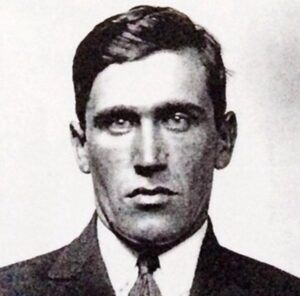Suspense author Sharon Short shares the rich history behind Middle Island, the real-life location that inspired her new novel, Trouble Island.

Years ago, I accompanied one of my daughters on her fifth-grade trip to Middle Bass Island, just off the shore of Ohio in Lake Erie. The class was visiting The Ohio State University’s Stone Laboratory, the oldest freshwater biological field station in the United States. I remember gazing across the sparkling water of the lake, and another chaperon commented that the dot of land on the horizon had once been home to a bootlegging gangster, who owned a luxurious mansion shrouded in secrecy. I was intrigued by this tidbit but before I could ponder it further, chaperoning duties required me to shift focus back to the kids.
But the notion of a Lake Erie island complete with a mysterious mansion as a staging spot for bootlegging stuck with me.
Time passed and eventually I turned my attention to researching the island to see if there was any merit to the anecdote my fellow chaperone had shared.
And, oh my, did it turn out that yes, there certainly was.
Lake Erie contains an archipelago of numerous islands, some uninhabited tiny dots, and others popular tourist locations in warmer months, such as Middle Bass and Kelley’s Island, both part of Ohio.
The mysterious island I’d gazed upon from the shore of Middle Bass Island is known simply as Middle Island (the names are easy to confuse), its 46 acres the southernmost land mass in Canada.

Various people have owned parts of Middle Island over the years, the most notorious of whom was Toledo, Ohio, bootlegging gangster Joe Roscoe, identified as the “gambling king” of Toledo by none other than FBI director J. Edgar Hoover. He owned part of the island and built a resort, with a lavish basement casino, on the grounds. The cover story was that Roscoe’s establishment was just for , and indeed that area of the lake was renowned for its good fishing opportunities.
But the location provided another opportunity: rum-running. (Though the alcohol in question was actually whisky, the rum-running term was applied anyway.) The island was ideally suited for this purpose. In Canada, Prohibition was on a province-by-province basis, ending in Ontario province last in 1927, while in the U.S., it was a nationwide mandate lasting until Dec. 1933. And the lake borders numerous U.S. ports.
What’s more, the resort gave Roscoe a lure to reel in politicians, police officers, judges, and other public officials. Once they’d enjoyed gambling, drinking, and sex with female sex workers, Roscoe essentially had them in his pocket.
His fellow gangsters (when at peace with him) also visited, including Al Capone and Alvin “Creepy” Karpis. (Allegedly, Karpis hired his doctor to remove his fingerprints; when the doctor made a veiled blackmail threat, Karpis took him fishing—and eventually the doctor washed up on an Ontario beach.)
With his superior speedboats and connections on the take, Roscoe eluded capture for years, until he hid Karpis in his Toledo apartment, and the apartment was raided by police.
But the island also has a fascinating history that precedes Roscoe. Evidence suggests that indigenous peoples once occupied the island between 500 BC-1500 AD. Escapees from slavery—and both sides of the Civil War—once used the island as a stopover as they fled to Canada. Abandoned on the northeast shore of the island is a lighthouse, built in the 1870s and functional until 1918, to guide shipping boats in the often treacherous waters of Lake Erie.
After Roscoe’s “fishing club” was shut down, a few other occupants of the island continued to live there. Eventually the mansion was abandoned, and in the late 1990s, vandals burned down what remained of the building. In 1999 the Nature Conservancy of Canada purchased the island and turned it over to Parks Canada. The island is part of Point Pelee National Park but is not open to visitors. It’s now a nature preserve, a home to double-breasted cormorants, great egrets, herons, Blue Ash trees, Lake Erie watersnakes, monarch butterflies, and many other species of plants and animals.
In my re-imagining of Middle Island to Trouble Island, I preserve the island’s history and nature, though I’ve amended the mansion and a few other details to fit my story.
Since I could not go to Middle Island itself, I went on a research trip to Middle Bass Island to read many resources in that island’s library, and hike the island’s nature trails. I often paused in my research to again gaze across the sparkling Lake Erie waters at Middle Island and imagine the fraught lives of gangsters on the island, while at the same time contemplating the island as fully returned to nature—a fitting and poignant finale to the island’s story.

SHARON SHORT is the author of fifteen published books. Her newest, Trouble Island, is historical suspense inspired by bootlegging and family history. Sharon is a contributing editor to Writer’s Digest, for which she writes the column, “Level Up Your Writing (Life)” and teaches for Writer’s Digest University. She is also a three-time recipient of the Individual Excellence Award in Literary Arts from Ohio Arts Council and has been a John E. Nance Writer in Residence at Thurber House (Columbus, Ohio). Sharon currently serves as President of the Midwest Chapter of Mystery Writers of America. As Jess Montgomery, she writes the historical Kinship Mysteries set in the 1920s and inspired by Ohio’s true first female sheriff. When not writing, Sharon enjoys spending time with family and friends, reading, swimming, and occasionally hiking.
